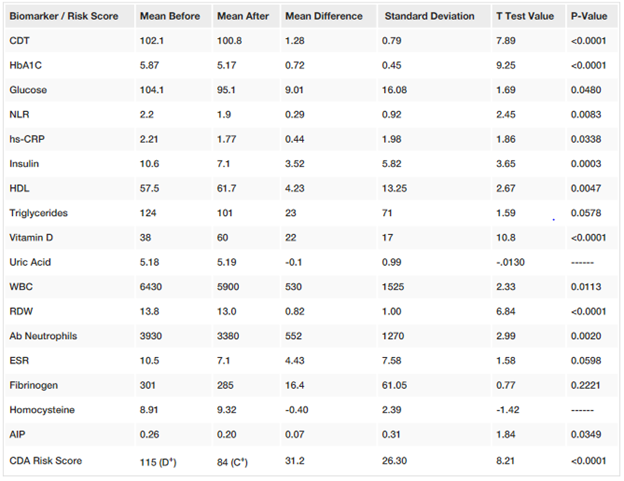When looking at the entire human organism and its function and dysfunction, clinicians recognize that contributing factors must be assessed in order to be effective for prevention, intervention, and resolution of disease. These include:
Astute researchers have developed a number of tools to evaluate the risk for chronic disease: [i]
Utilizing these tools and personalized interventions, including dietary adjustments and nutrient supplementation, 94% of a 70-person cohort lowered their disease risk and improved their health “scores” while the group as a whole improved their “grade” from a D+ to a C+.
Reducing whole body inflammation was the primary objective of each encounter, not just reducing the glycemic value of food.
Examples included switching out proinflammatory for anti-inflammatory cooking oils, lowering glycemic value and load of substituted foods, reducing frequency of fast food consumption, improving oral hygiene, managing stress, establishing better sleep and rest patterns, enhancing hydration, improving micronutrient density of foods consumed, establishing more frequent movement routines, and consuming more gut-supporting foods.
Results indicate significant success in reducing chronic disease risk in this 70-person cohort, reflected in improvements in “before” and “after” biomarker values:

CDT is the Chronic Disease Temperature biomarker score as a relative value with 98.6 considered optimal and elevated values indicating chronic risk; HbA1C is expressed as a %; Glucose is expressed as mg/dL; NLR is the neutrophil to lymphocyte ratio; hs-CRP is high sensitivity C-reactive protein or C-reactive protein, cardiac expressed as mg/L; insulin is expressed as uIU/mL; HDL is expressed as mg/dL; triglycerides are expressed as mg/dL; vitamin D is expressed as ng/mL; uric acid is expressed as mg/dL; WBC is the white blood cell count expressed as cells/uL; RDW is the red blood cell distribution width expresses as a %; Ab neutrophils are neutrophils (absolute) expressed as cells/uL; ESR is the sedimentation rate-Westergren expressed in mm/hr; fibrinogen is fibrinogen activity expressed as mg/dL; homocysteine is expressed as umol/L; and AIP is the Atherogenic Index of Plasma expressed as the log(Triglycerides/HDL)
Source: Lewis, Thomas J et al. “Reduction in Chronic Disease Risk and Burden in a 70-Individual Cohort Through Modification of Health Behaviors.” Cureus vol. 12,8 e10039. 26 Aug. 2020, doi:10.7759/cureus.10039. This is an open access article distributed under the terms of the Creative Commons Attribution License, which permits unrestricted use, distribution, and reproduction in any medium, provided the original author and source are credited.
Similar interventions apply to mitigating COVID-19 risk and severity. Primary goals of treatment should include balancing inflammation, minimizing oxidative stress, enhancing antioxidant levels, and addressing the gut microbiome. These goals are the same whether pre-COVID-19, during COVID-19, or post-COVID-19. Diet and nutrition support can be instrumental in reaching these goals.[ii]
A pro-inflammatory diet is often overlooked as an underlying reason for unresolved inflammation. Nurses’ Health study data reveals that an inflammatory pattern is “high in sugar-sweetened soft drinks, refined grains, diet soft drinks, and processed meat but low in wine, coffee, cruciferous vegetables, and yellow vegetables.”[iii] Unfortunately, this pattern mirrors that of the Standard American Diet (SAD).
Systemic review revealed that even one high-fat processed meal (white bread, butter, cheese, and a milkshake) doubled values for serum IL-6 within six hours of the meal.[iv]
Nutrition must be considered a first-line of defense against COVID-19 as it plays an integral and distinct role in immune function and competence. Suboptimal nutrition increases vulnerability to viral infection, morbidity, and mortality. The infection, in turn, increases micronutrient needs including zinc, selenium, and vitamins A, Bs, C, and D.[v]
Next Up - A Healthy Diet is Primary Prevention for COVID-19
[i] Lewis, Thomas J et al. “Reduction in Chronic Disease Risk and Burden in a 70-Individual Cohort Through Modification of Health Behaviors.” Cureus vol. 12,8 e10039. 26 Aug. 2020, doi:10.7759/cureus.10039
[ii] Minich, D M, and P J Hanaway. “The Functional Medicine Approach to COVID-19: Nutrition and Lifestyle Practices for Strengthening Host Defense.” Integrative medicine (Encinitas, Calif.) vol. 19,Suppl 1 (2020): 54-62.
[iii] Schulze, Matthias B et al. “Dietary pattern, inflammation, and incidence of type 2 diabetes in women.” The American journal of clinical nutrition vol. 82,3 (2005): 675-84; quiz 714-5. doi:10.1093/ajcn.82.3.675
[iv] Minich, D M, and P J Hanaway. “The Functional Medicine Approach to COVID-19: Nutrition and Lifestyle Practices for Strengthening Host Defense.” Integrative medicine (Encinitas, Calif.) vol. 19,Suppl 1 (2020): 54-62.
[v] Souza, Ana Carolina Remondi, et al. "Zinc, Vitamin D and Vitamin C: Perspectives for COVID-19 With a Focus on Physical Tissue Barrier Integrity." Frontiers in Nutrition 7 (2020): 295.